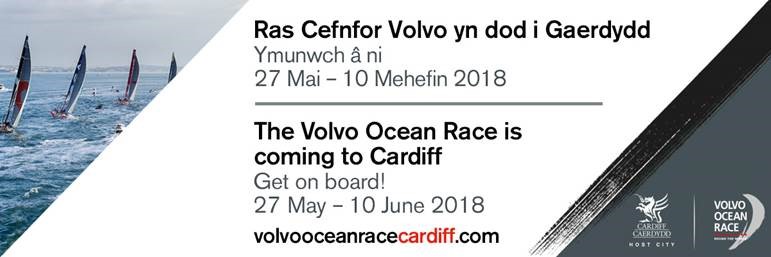
Friday February 16 marks 100 days to go before the Volvo Ocean Race, the world’s toughest and most prestigious sailing event, arrives in Cardiff on Sunday May 27 for a 14 day stopover.
The leading boats in the fleet are expected to reach Cardiff Bay on Bank Holiday Monday, having made the 2,900 nautical mile voyage across the Atlantic from Newport (the Rhode Island, US one!). This much sought after Atlantic stopover enhances Cardiff’s reputation as a maritime city across the world as this is the first UK visit in 12 years for a race that started life in 1973. It will bring a significant financial boost to the Welsh economy in the Visit Wales designated ‘Year of the Sea’.
Minister for Culture, Tourism and Sport, Lord Elis-Thomas, said: “With 100 days to go, we’re getting very excited about the arrival of the Volvo Ocean Race. We’re thrilled to be playing our part in this event – especially during our celebration of our spectacular shores during this Year of the Sea. The Cardiff stopover will be a great boost to the Welsh economy, and provide more a positive profile for Cardiff and Wales around the globe.”
The 45,000 nautical mile Volvo Ocean Race set out from Alicante last October, journeying across the great oceans with stopovers in some of the most famous maritime destinations such as Hong Kong, Cape Town, and Auckland, where the fleet is currently headed. When it leaves Cardiff on June 10, it moves on to Gothenburg and The Hague for its finale at the end of June.
While the fleet is in Cardiff, the Race Village will be a huge visitor attraction, with visitors from around the globe enjoying the Volvo Ocean Race cinema, trade stalls and live music on the waterfront. The festival will have a Welsh flavour, with Welsh producers offering locally-sourced food and drink – from bars offering real ale to the most popular street food vendors. The Race Village also hosts a global Ocean Summit business event, attracting high calibre speakers on the issue of clean seas, a key campaign focus of the Volvo Ocean Race, and enabling Wales to show off our sustainability credentials. Any volunteers interested in being involved in the Race Village May 27 – June 10 can register interest on volvooceanracecardiff.com.
One of the boats, Turn The Tide On Plastic, is helping to spread the message about the damage caused by plastic in the oceans, and is actually collecting data on microplastics as it voyages around the world. Amongst its crew is Welshman Bleddyn Môn, who’s looking forward to coming home in May. Bleddyn said: “The Volvo Ocean Race is a huge test of ability and resilience, and it’s been one of the most amazing experience of my life. As a Welshman, it’s terrific that Cardiff is the UK stopover, and I’m so looking forward to catching up with family and friends when we reach Cardiff Bay in May.”
Cllr. Peter Bradbury, Cardiff Council Cabinet Member for Culture and Leisure said: “We are extremely excited to welcome the Volvo Ocean Race to Cardiff, joining some of the most well-known ports around the globe in hosting this prestigious race. There’s a terrific competition happening right now on the other side of the world, and with 100 days to go, we’re getting excited to welcome the fleet to Cardiff where they will provide a real spectacle for locals and visitors.”
Volvo Ocean Race Facts
The Volvo Ocean Race is held every three years. Each of the entries has a sailing team of between seven and eleven professional crew, depending on the gender ratios, who race day and night for more than 20 days at a time on some of the legs. No fresh food is taken on board, so the crew lives off freeze-dried fare; they will experience temperature variations from −5 to +40 degrees Celsius and will only take one change of clothes.
Volvo Ocean Race Teams:
Turn The Tide On Plastic – United Nations Environment’s Clean Seas
Team AkzoNobel, The Netherlands
Dongfeng Race Team, China
MAPFRE, Spain
Vestas 11th Hour Racing, USA / Denmark
Sun Hung Kai / Scallywag, Hong Kong
Team Brunel, The Netherlands
Skippers are allowed to change the team line-up on a leg-by-leg basis. Returning to the Southern Oceans means teams will face more gruelling conditions for longer. All male crews are allowed seven members, but they can take up to 2 females. If the gender split is event, they are allowed a team of 10, while all female crews can consist of 11 members. Skippers can nominate different crew combinations per leg. Each team must have at least two members under 30.


